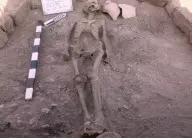
Egypt unearths 3000 years old "Lost Gold City" in Luxor
text_fieldsCairo: A 3000-year-old "Lost Gold City" (LGC) was discovered in Luxor by an Egyptian archaeological mission, Xinhua news agency reported. The mission was headed by renowned Egyptian archaeologist Zahi Hawass, cooperating with the Supreme Council of Antiquities in Egypt. The city, known as "The Rise of Aten", dates back to Amenhotep III and king Tutankhamun.
Hawass termed the discovery as the largest city ever found in Egypt. "The LGC was founded by one of the greatest rulers, Amenhotep III, the ninth king of the 18th dynasty who reigned from 1391 till 1353 B.C.," he said.
The LGC is believed to be the most significant administrative and industrial settlement in the Egyptian empire on Luxor's west bank. The mission found the city well preserved with almost complete walls and rooms filled with daily life tools. It unearthed some of the city's streets, flanked by houses, with the walls up to three metres high.
In the southern part of the city, a bakery and a cooking area complete with ovens and storage pottery were found. "From its size, we can state the kitchen was catering a huge number of workers and employees," Hawass said.
A second part of the city that is yet to be uncovered is predicted to be administrative and residential areas. It is fenced with zigzag walls and has only an access point to lead inside. A third area identified as a workshop where bricks were made for construction.
"The discovery of this lost city is the second most important archaeological discovery since the tomb of Tutankhamun," said Betsy Brian, professor of Egyptology at Johns Hopkins University in the United States.
The mission's main objective was to date the establishment of the city, which was done successfully after rings, scarabs, coloured pottery vessels, and mud bricks beating seals of Amenhotep III's cartouche were found.
The excavation area where the works started in September 2020 is located between Rameses III's temple at Medinet Habu and Amenhotep III's temple at Memnon.
(With inputs from IANS)























